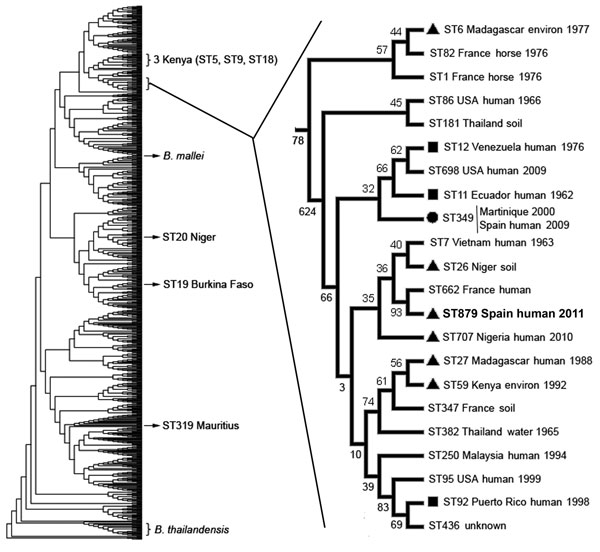Volume 19, Number 10—October 2013
Dispatch
Melioidosis in Traveler from Africa to Spain
Figure

Figure. . Phylogenetic position of Burkholderia pseudomallei isolate BpSp2, sequence type (ST) 879 (boldface), from a patient in Spain who had traveled to Africa. The dendrogram was built by using 852 isolates from the public B. pseudomallei database (http://bpseudomallei.mlst.net). The clade in which most STs from Africa, South America, and the Caribbean are located has been enlarged; location, source type, and year collected are indicated for each isolate. Black circle indicates isolates from Africa; black squares indicate isolates from South America or the Caribbean; black triangles indicate ST349 from Martinique and the first patient described in Spain (7). Location of other STs from Africa, B. mallei, and B. thailandensis are also indicated. Environ, environment.
References
- Brilhante RS, Bandeira TJ, Cordeiro RA, Grangeiro TB, Lima RA, Ribeiro JF, Clinical-epidemiological features of 13 cases of melioidosis in Brazil. J Clin Microbiol. 2012;50:3349–52. DOIGoogle Scholar
- Meckenstock R, Therby A, Marque-Juillet S, Monnier S, Khau D, Pangon B, Cutaneous melioidosis in adolescent returning from Guadeloupe. Emerg Infect Dis. 2012;18:359–60.PubMedGoogle Scholar
- Bremmelgaard A, Bygbjerg I, Høiby N. Microbiological and immunological studies in a case of human melioidosis diagnosed in Denmark. Scand J Infect Dis. 1982;14:271–5.PubMedGoogle Scholar
- Wall RA, Mabey DC, Corrah PT, Peters L. A case of melioidosis in West Africa. J Infect Dis. 1985;152:424–5. DOIGoogle Scholar
- Issack MI, Bundhun CD, Gokhool H. Melioidosis in Mauritius. Emerg Infect Dis. 2005;11:139–40. DOIGoogle Scholar
- Borgherini G, Poubeau P, Paganin F, Picot S, Michault A, Thibault F, Melioidosis: an imported case from Madagascar. J Travel Med. 2006;13:318–20. PubMed DOIGoogle Scholar
- Cuadros J, Gil H, De Miguel J, Marabé G, Gómez-Herruz TA, Lobo B, Melioidosis imported from West Africa to Europe. Am J Trop Med Hyg. 2011;85:282–4. PubMed DOIGoogle Scholar
- Salam AP, Khan N, Malnick H, Kenna DT, Dance DA, Klein JL. Melioidosis acquired by traveler to Nigeria. Emerg Infect Dis. 2011;17:1296–8. PubMed DOIGoogle Scholar
- Amezyane T, Lecoules S, Algayres JP. Mycotic iliac aneurysm associated with Burkholderia pseudomallei. Int J Infect Dis. 2010;14(Suppl 3):e381–2. PubMed DOIGoogle Scholar
- Karger A, Stock R, Ziller M, Elschner M, Bettin B, Melzer F, Rapid identification of Burkholderia mallei and Burkholderia pseudomallei by intact cell matrix-assisted laser desorption/ionisation mass spectrometric typing. BMC Microbiol. 2012;12:229. PubMed DOIGoogle Scholar
- Clinical and Laboratory Standards Institute. Performance standards for antimicrobial susceptibility testing. Twenty-first informational supplement. M100–S21. Wayne (PA): The Institute; 2011.
- Godoy D, Randle G, Simpson AJ, Aanensen DM, Pitt TL, Kinoshita R, Multilocus typing and evolutionary relationships among the causative agents of melioidosis and glanders, Burkholderia pseudomallei and Burkholderia mallei. J Clin Microbiol. 2003;41:2068–79. PubMed DOIGoogle Scholar
- Tamura K, Dudley J, Nei M, Kumar S. MEGA4: Molecular Evolutionary Genetics Analysis (MEGA) software version 4.0. Mol Biol Evol. 2007;24:1596–9. PubMed DOIGoogle Scholar
- Limmathurotsakul D, Thammasart S, Warrasuth N, Thapanagulsak P, Jatapai A, Pengreungrojanachai V, Melioidosis in animals, Thailand, 2006–2010. Emerg Infect Dis. 2012;18:325–7. PubMed DOIGoogle Scholar
- Zong Z, Wang X, Deng Y, Zhou T. Misidentification of Burkholderia pseudomallei as Burkholderia cepacia by the VITEK 2 system. J Med Microbiol. 2012;61:1483–4. PubMed DOIGoogle Scholar